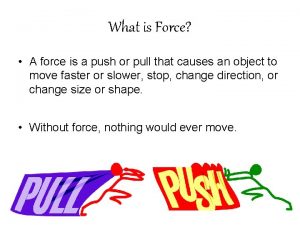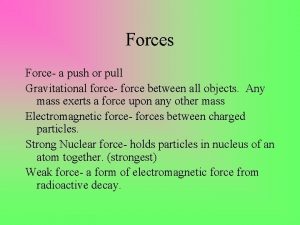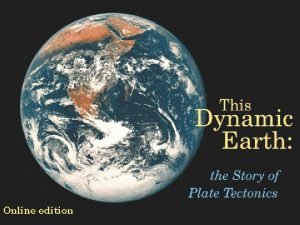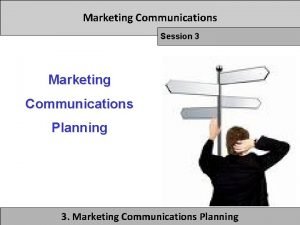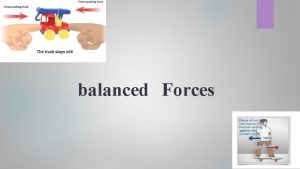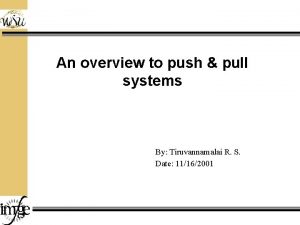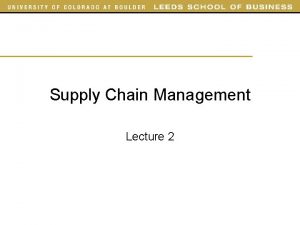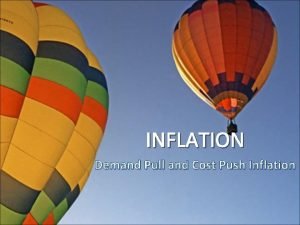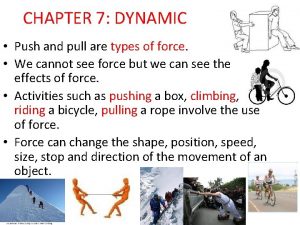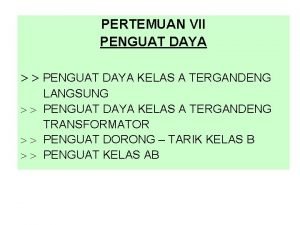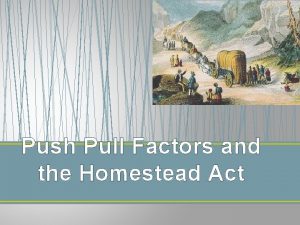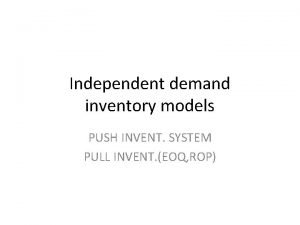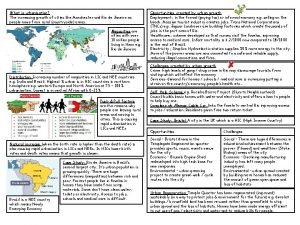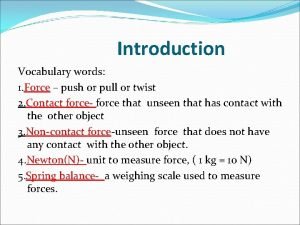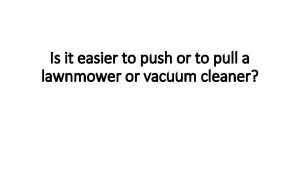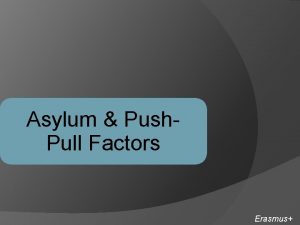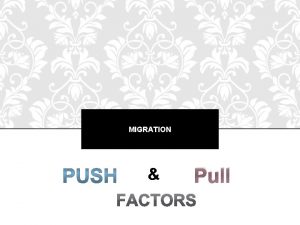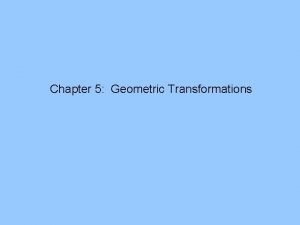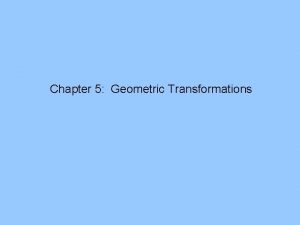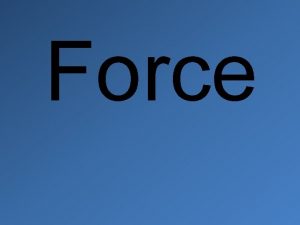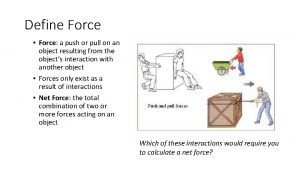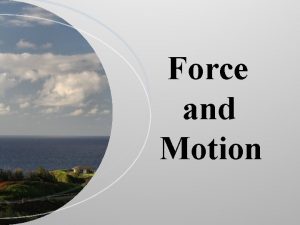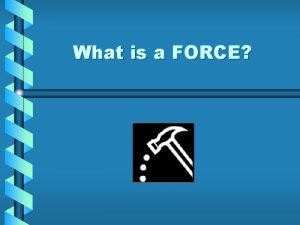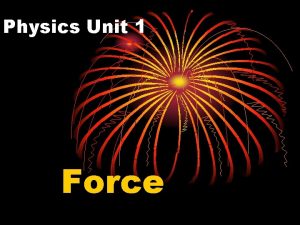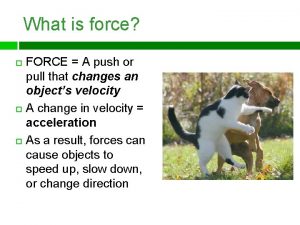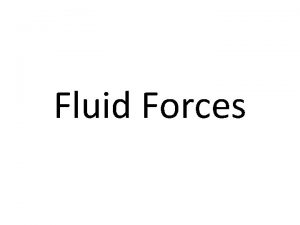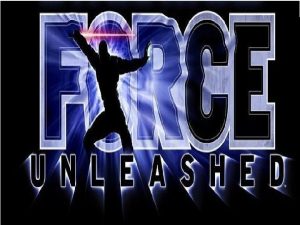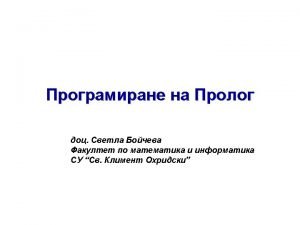force Force is a push or a pull






















- Slides: 22

force Force is a push or a pull that alters the state of motion of a body and can be calculated using the following equation: Force = mass x acceleration. (f-ma) Usain example Mass = 94 kg Acceleration 2. 41 m/s/s 94 x 2. 41 = 226. 5 N Your force Mass = your weight kg Acceleration = ………. . m/s/s Mass x acceleration ………. . N

Complete the chart facts Name 100 m Velocity Time 13. 4 Momentum Weight 88 kg Acceleration 20 m time 3. 4 secs Force Equation Result

Force �Force is essential to motion �Internal force � Generated by muscular contraction. � E. g. rectus Femoris to extend the knee in the 100 m sprint. �E. g. �External force � Generated by forces outside the body and acts upon it. . � E. G. weight, reaction � E. G. Wind resistance, friction

So what can force DO penalty? Action Example in sport 1. Force can decelerate a body. Force can create motion Force can change the shape of a body Force can change the direction of a body Force can accelerate a body

Unbalanced Net Forces If net force is positive e. g. 1, the body will accelerate. If net force is negative e. g. -1, the body will decelerate.

Weight Reaction Friction Air Resistance

Horizontal Force - Friction is the force that opposes the motion of two surfaces in contact Friction is measured in Newtons (N) It is always present when two bodies are in motion and have contact Friction is shown on a diagram by a horizontal arrow extending in the same direction as motion from the point of contact parallel to the sliding surface

Roughness of the contact surface – this increases friction Roughness of the ground surface – this increases friction Temperature – by increasing the temperature of the ground friction is increased Friction is affected by…. Size of normal Reaction - by increasing normal Reaction, friction is increased

Shape – the more aerodynamic the shape, the lower the air resistance. Streamlining minimises air resistance Velocity– increasing velocity increases air resistance Frontal Cross-Sectional Area – by decreasing the frontal cross-sectional area, air resistance decreases Air Resistance is affected by…. Smoothness of the Surface - by increasing the smoothness of the surface, air resistance decreases

Free Body Diagrams These are clearly labelled sketches showing all of the forces acting on a body at a particular instant in time Think! What is happening in the picture? Is Weight greater than Reaction (Vertical Forces)? Is Friction greater than Air Resistance (Horizontal Forces)?

G 453 June 2014 Q 4 a)



l E F Example of a second class lever

l Example of a third class lever E F

Example of a first class lever

mechanical disadvantage third class lever � Where the load arm is greater than the effort arm, a large effort is required to move a relatively small load. Bicep curl/ straight arm raise

Second class Where the effort arm is greater than the load arm , a large force can be moved with a relatively small force. E L

Mechanical advantage E E Can increase velocity and acceleration if movement can be created. L



summary � 1/2/3 class levers �Length of load are and effort arm will impact on movement and force needed. � 2 nd class 3 rd class THE GREATER THE EFFORT ARM THE LESS EFFORT IS NEEDED TO MOVE THE SAME LOAD. However, if the effort is greater than the load, can increase velocity and acceleration. Where the load arm is greater than the effort arm, a large effort is required to move a relatively small load.
 Gravity force
Gravity force Is gravitational force a push or pull
Is gravitational force a push or pull Angle of pull example
Angle of pull example Slab pull en ridge push
Slab pull en ridge push Push pull profile strategies marketing communications
Push pull profile strategies marketing communications Abe goldman
Abe goldman Promotion mix
Promotion mix Push communication
Push communication Balanced forces definition
Balanced forces definition Push and pull
Push and pull Push pull in supply chain
Push pull in supply chain Landflucht push und pull faktoren
Landflucht push und pull faktoren Méthode pull veille informationnelle
Méthode pull veille informationnelle Cost push inflation
Cost push inflation Push and pull chapter 7
Push and pull chapter 7 Push pull class b power amplifier
Push pull class b power amplifier Push-pull factors definition
Push-pull factors definition Push vs pull inventory
Push vs pull inventory Push and pull factors of urbanisation
Push and pull factors of urbanisation Push and pull vocabulary
Push and pull vocabulary Push und pull faktoren
Push und pull faktoren Market pull examples
Market pull examples Push
Push
